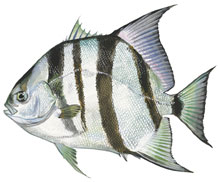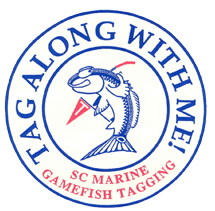Marine - Species
SC Species Regulations for Atlantic Spadefish
Saltwater Fishing License required.
No state size or bag limits.
Federal Waters Limit: Not to exceed 20 per person per day in aggregate with all other snapper grouper complex species. No size limits or seasonal fishery closure.
Atlantic Spadefish (Chaetodipterus faber)
General Description
Silver-gray to yellowish; disc shaped, nearly as deep as long; sides with 4 – 6 black vertical bars that may fade with age. First rays of anal and second dorsal fins elongate, forming a point. First dorsal fin spiny. Mouth small.
Average Size
12 - 18 inches, 6 pounds;
South Carolina State Record: 14 pounds, 2 ounces (2005);
maximum age: at least 8 years
Habitat
Adults: Inhabit nearshore and offshore waters, typically over rocky or live bottom habitat and in association with wrecks, artificial reefs, and piers.
Juveniles:Tolerate wide salinity ranges; utilize estuaries, harbors, rivers, and tidal creeks, often in association with hard bottom, or sub tidal oyster reefs.
Reproductive Cycle
- Both sexes mature by 1 year of age. Approx. size at maturity: males – 3 ¾ inches, females – 4 ¾ inches.
- Spawning occurs at the surface in offshore waters during May – September (peak May-June).
- Larvae inhabit warm, higher salinity nearshore coastal surface waters. Juveniles often utilize estuaries as nursery grounds.
Foraging Habits
- Generalist feeders during daylight on a wide variety of invertebrate prey. Foraging occurs throughout the water column, along bottom, and on, around, or within manmade structure.
- Prey includes sponges, polychaete and sabellid worms, tunicates, hydrozoans, soft corals, amphipods, anemones, algae, and crustacean larvae.
Availability/Vulnerability to Harvest
- Distribution is primarily temperature dependent. Present in nearshore waters April – November. Juveniles leave estuaries during fall and join adults in shallow offshore waters; younger fish may remain near offshore artificial reefs almost year-round. Older fish probably overwinter in deep water offshore; some may also move southward as nearshore waters cool during fall.
- Form schools of a few to several hundred fish. Strong schooling behavior in vicinity of manmade structure could increase vulnerability to fishing pressure.
- No commercial fishery exists in South Carolina.
- Conservation concerns: degradation or loss of nearshore larval habitat and estuarine nursery grounds; degradation or loss of limited nearshore live and hard bottom habitats; potential for overfishing; lack of knowledge regarding basic biology of spadefish in South Carolina waters.
Literature Cited
Bell M. 2005. Atlantic spadefish. In: Comprehensive Wildlife Conservation Strategy. Columbia, S.C., S.C. Department of Natural Resources. Available: https://www.dnr.sc.gov/cwcs/pdf/Atlanticspadefish.pdf. Accessed: September, 2009.
Ditty JG, RF Shaw, JS Cope. 1994. A re-description of Atlantic spadefish larvae, Chaetodipterus faber (family: Ephippidae), and their distribution, abundance, and seasonal occurrence in the northern Gulf of Mexico. Fish Bull 92: 262-274.
Hayse JW. 1987. Feeding habits, age, growth, and reproduction of Atlantic spadefish, Chaetodipterus faber (Pisces: Ephippidae), in South Carolina. Fish Bull 88: 67-83.
Schwartz FJ. 1998. Biological and ecological relationships for young Atlantic spadefish, Chaetodipterus faber (Pisces: Family Ephippidae) collected in the Cape Fear River estuary and adjacent waters, North Carolina, 1973 through 1978. J Elisha Mitchell Soc 114: 23-30.


